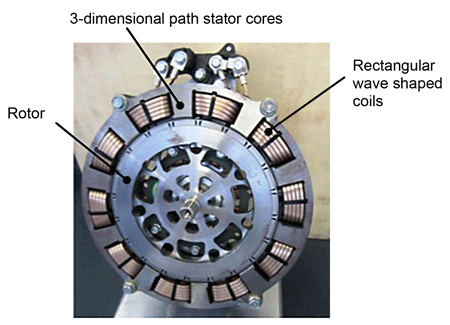Much like the automotive market, the electric motor market is undergoing a dramatic revolution aimed at higher performance and reduced energy consumption. This is not to suggest that the traditional radial flux motor design will be totally replaced but there are numerous new and existing applications where weight, size, performance, and energy consumption will play a more dominant role in the motor selection. The old adage of “one size fits all” can no longer be used in the design of electric motors with each application having its own unique requirements. What are the current new motor design types under consideration and what are their potential advantages?
Non-Traditional Radial Flux Designs
One exciting development is from EVR Motors - the trapezoidal radial flux motor. This motor concept boasts high torque density while offering the option of using expensive rare earth magnets. What makes this design so exciting is the trapezoidal tooth shape and pre-wound trapezoidal coils possessing a high fill factor with no end turns. These advantages coupled with a 3D flux path creates greater power and high torque density in half the size - advantages often seen in axial flux motors but with the high RPM possibilities, inherent of a radial flux design.
.jpg?width=1920&height=1080&name=EVR%20Chart%20%20(3).jpg)
The attached chart shows the project power output of this design.
This exciting technological development is already being adopted in electric mobility applications from scooters to electric buses.
Axial Flux Motors
The axial flux motor has been around nearly as long as the standard induction motor. Advances in fabrication technology and magnet material are pushing this design into new applications where size, weight and cost restrictions are important design considerations. The ability to use larger rotor size relative to the same OD generates more torque for the same size. Thus, creating an ability to reduce the motor size, or the number of gear sets - for the same total output. Companies like Regal Rexnord with their SMART motor system and Infinitum pushing the envelope creating high efficiency motors.
.jpg?width=1920&height=1080&name=EVR%20Chart%20%20(4).jpg)
Image courtesy of YASA Motors
Pushing the axial flux motor to its zenith of performance are companies like YASA with the yokeless axial flux design. This concept offers the highest torque, lowest weight, and maximum design flexibility. It also eliminates the potential deflections inherent in conventional axial flux motors. By utilizing magnets on both the top and bottom of the rotor, you significantly increase torque with no additional copper usage. Until recent advances, this topology was considered both cost-prohibitive and difficult to manufacture.
Transverse Flux Motors
The transverse flux motor (TFM) was first envisioned in the late 1800s - using a copper winding circumferentially around the axis of rotation. This concept has been used in automotive alternators since the 1960s, the claw pole motor. Benefits of this design are high power density and design freedom. However, the cons of the TFM design are high flux leakage, cogging torque, and lower power factors. The recent interest in the TFM design has focused on eliminating or minimizing the negative aspects of the TFM. These advancements include the use of ferrite magnets to prevent saturation of the back iron, the use of magnetic shunts to prevent leakage, and the use of Halbach array magnets to minimize the cogging torque. There is a hybrid design that utilizes transverse flux in the stator and horizontal flux in the rotor which improves magnet utilization and further increases power factors.
Soft Magnetic Composites – Ultimate Design Freedom
What do the three unique motor topologies have in common – unique 3D shape with a non-traditional magnetic flux path that is not easily produced via conventional electrical steel stamping technology.
How do you enable the freedom to produce these uniquely shaped topologies – enter Soft Magnetic Composite technology.
The solution to both the 3D shape and 3D flux path is soft magnetic composites (SMCs). This novel manufacturing process offers a customizable approach to your motor requirements. Starting out as a ferrous particulate material that is electrically insulated, the shape is then compacted via enhanced powder metallurgy technology and then thermally cured to fully establish the electrical insulation. Result; a net shape component that has greater than 95% material utilization requiring less than 85% of the total energy to produce the component with performance equal to conventional steel laminations. It should also be noted that SMCs are a sustainable technology and components can be easily recycled to reclaim both the copper and expensive magnet material.
Looking to learn more about how SMCs can help you break free from the restrictions of laminations? We rounded up a few of our favorite articles below to help you discover the design freedom enabled by SMC technology to tailor the magnetic performance of your specific application – whether its high frequency, core loss abatement, controlled permeability, and/or saturation density.
 Frequency Control 101 in Magnetic Electric Motor Materials (horizontechnology.biz)
Frequency Control 101 in Magnetic Electric Motor Materials (horizontechnology.biz)
 BLDC Motor Design: Segmentation Using Powder Metallurgy (horizontechnology.biz)
BLDC Motor Design: Segmentation Using Powder Metallurgy (horizontechnology.biz)
Soft Magnetic Composites and Permeability (horizontechnology.biz)
Contact us today to learn even more!



